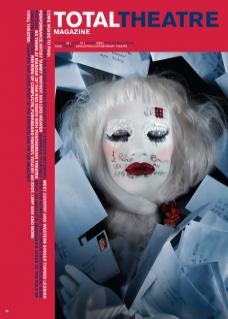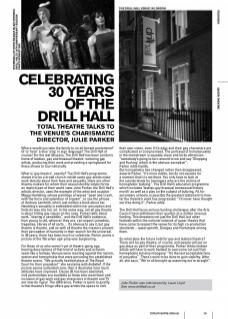Where would you take the family to an all-female pantomime? Or to ‘hear’ a diva ‘sing’ in sign language? The Drill Hall of course! For the last 30 years, The Drill Hall has been London’s home of lesbian, gay and bisexual theatre: nurturing gay artists, producing their work and providing a springboard for these shows to tour nationally.
What is ‘gay theatre’, exactly? The Drill Hall’s programme shows it to be a broad church: whilst some gay artists make work directly about their lives and sexuality, there are other theatre-makers for whom their sexual identity simply forms an implicit part of their world view. Julie Parker, the Drill Hall’s artistic director, uses the example of the artist and sculptor Maggi Hambling, whose paintings of waves “peak and crash, with the force and splendour of orgasm”, to use the phrase of Andrew Lambirth, who’s just written a book about her. Hambling’s sexuality is embedded within her perception and finds its way into her art. In the same way, not all gay theatre is about hitting gay issues on the nose. Parker talks about work “sharing a sensibility”, and the Drill Hall’s audience, from young to old, whoever they are, can expect comedies, tragedies, stories of all sorts ... it’s obvious to say it, but gay theatre is theatre, and as with all theatre the creators present their perception of humanity in their search for the universal. In 30 years, there has been much to celebrate. Parker paints a picture of the 70s when agit-prop was burgeoning.
For those of us who weren’t yet of theatre-going age, hearing descriptions of that kind of activity and activism seem like a fantasy. Venues were reacting against the racism, sexism and homophobia that were pervading the established theatre scene. “We actually heckled plays at The Royal Court for their prejudice!” she exclaims with disbelief. If the picture seems outlandish now, then it illustrates how much attitudes have improved. Clause 28 has been abolished, civil partnerships are available to those who want them and inclusion of gay work and gay characters in theatre and TV are now de rigeur. The difference, Parker is quick to qualify, is that theatre’s fringe offers gay artists the space to visit their own vision, even if it’s edgy and their gay characters are complicated or compromised. The portrayal of homosexuality in the mainstream is squeaky clean and lacks dimension - “somebody’s going to turn around to me and say ‘Shopping and Fucking’ which is the obvious exception”, Parker adds hastily.
But homophobia has changed rather than disappeared, asserts Parker. “It’s more subtle, but do not assume for a moment that it is not there. You only have to look at the suicide levels for teenagers who are the victims of homophobic bullying”. The Drill Hall’s education programme which includes ‘lesbian gay bisexual transsexual history month’ as well as a play on the subject of bullying, Fit, for secondary schools, is possibly the greatest testament to how far the theatre’s work has progressed: “I’d never have thought we’d be doing it”, Parker adds.
The Drill Hall faces serious funding challenges after the Arts Council have withdrawn their quarter-of-a-million revenue funding. This threatens not just the Drill Hall, but other festivals within the national network of queer theatre that have come to respect the venue for its high co-production standards – queerupnorth, Glasgay and Homotopia among them.
So what does the future hold for gay and lesbian theatre? There will be gay theatre, of course, and people will put on gay plays as part of their programme. Parker thinks lesbian artists will have to work hardest to overcome not just from homophobia but also misogyny: “It’s the last acceptable face of prejudice”. There’s work to be done to gain visibility. After all, she says, “We’re all brought up assuming we’re straight”.
Julie Parker was interviewed by Laura Lloyd See www.drillhall.co.uk

